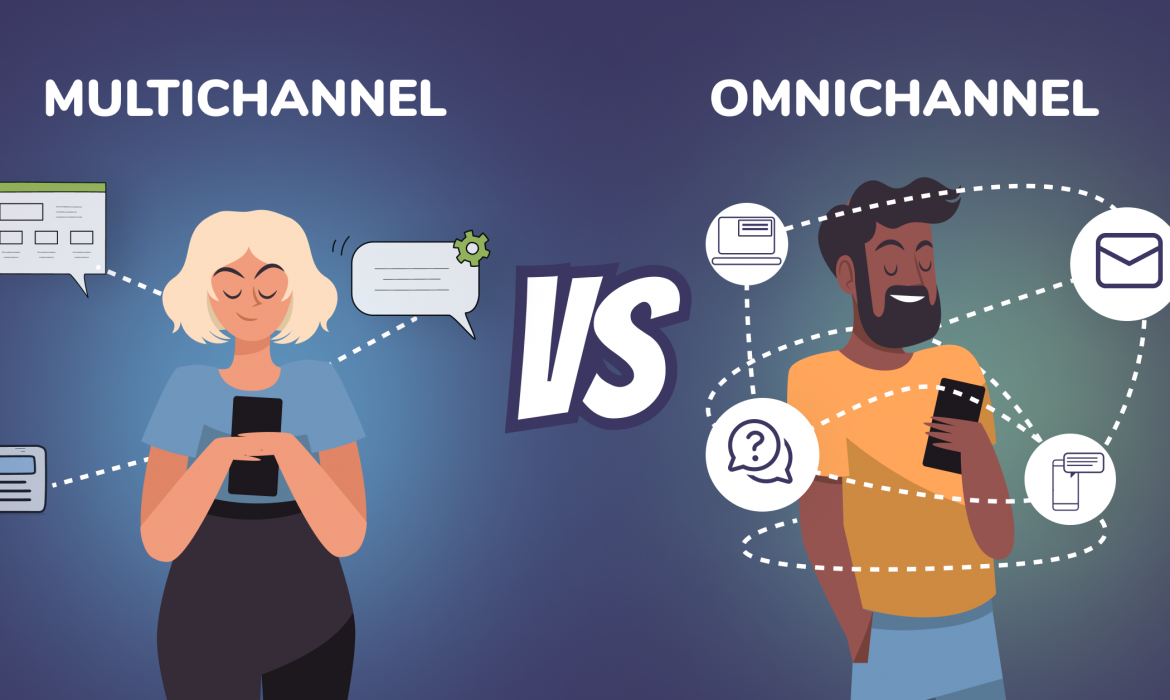Omnichannel vs Multichannel: Differences, Examples and Tips
Although they may seem similar at first, omnichannel and multichannel marketing have their differences. Multichannel marketing works for businesses looking to expand their reach. On the other hand, Omnichannel marketing allows companies to fine-tune it.
Omnichannel marketing requires more work and focus from your employees to implement. However, its benefits make it worth the extra work and time. Many experts claim that the benefits are well worth the extra work and time.
By applying an omnichannel strategy to your online marketplace, you can retain customers and continue to grow your business.
Let’s take a closer look at these two different marketing methods.
What Is Multichannel Marketing?
It means that you can use many channels to reach your customers, or that your customers have many ways (channels) to reach and interact with you.
In other words, it is the channel the customer uses to reach you. For example, when a user shopping from your e-commerce site encounters a problem, they can call customer service or get help from live chat support.
Customer services are important for a better buying experience. Which channel the customer prefers is the important part of all.
The customer experience is one of the key factors in Multichannel.
For example, a brand that sells products in two categories should make market analyzes of its categories and sell it in marketplaces where it will meet the target audience directly.
Let’s say you don’t know which marketplace is best for the target audience of your products. At this point, Multichannel marketing gives you the message that wherever you sell the product, you can get the customer to buy it from a single channel.
What Is Omnichannel Marketing?
The omnichannel marketing aims to reach the target audience simultaneously from multiple channels.
Omnichannel is a strategy used by many advanced companies today with a new-generation marketing strategy.
Think about Digital Marketing channels like Facebook, Instagram, Twitter. Or, your website that belong to your business.
All these resources are not expected to be used separately in Omnichannel management. That’s why the relationship between your channels and your customers should be binding to deliver a consistent customer engagement.
In other words, if your potential customer has seen your company’s advertisement on the posters, they will head to your website or social media channels to review your product or company.
Moreover, other channels should also support your advertisement on the banner.
The main purpose of the Omnichannel Marketing is to make customer buy a product that they have already viewed on your website or in your physicall store, using other channels.
That is, if your potential customer reviews a product on your website but gives up on buying it, sending a discount or reminder email in the product or, creating engagement in the brains of your customer on Social Media can be helpful.
What Are The Key Differences Between Omnichannel And Multichannel?
The main difference between Omnichannel and Multichannel is the integration methods they use.
Your customers can reach you through different channels, but Multichannel does not make the channels work together in management. This is because each channel provides different services, and operates separately from the others. Multichannel marketing is all about building the widest network to keep higher customer engagement.
Customer is the heart of omnichannel marketing. The omnichannel approach focuses on the customer’s needs and offers customers a personalized experience. Since the channels here are interconnected, it allows the customer to access information from any channel.
Companies using the omnichannel strategy must ensure that all departments are in harmony. For example, the social media team, customer service, and sales team should deliver a consistent message to the customer.
Advantages and Disadvantages of Multichannel Marketing
Multichannel is very effective in increasing the visibility and awareness of your brand. As it is in contact with the customer through many different channels. It allows you to tailor and focus your strategy on the channel that might be more effective in terms of performance.
Against this advantage, multichannel also has some disadvantages. Each channel is treated as its own strategy, performance metrics, and different customer experience.
Consumer experience can be disconnected if the brand uses way more channels. This can lead to a negative experience for your brand awareness.
Having data in separate channels also makes it difficult for brands to get a holistic view of their customers.
Advantages and Disadvantages of Omnichannel Marketing
The omnichannel strategy allows you to provide a more relevant experience that drives greater customer engagement through higher levels of personalization.
For example, a potential customer first viewed your furniture company on Instagram. You can then get information about the price of your products through Google Shopping. It can come to your store to buy. In omnichannel marketing, all these interactions are interconnected. Whichever way the customer first interacts with your brand, they will have a more relevant, organized, and understandable omnichannel experience with your brand. That is with using multiple channels.
The biggest disadvantage of the omnichannel strategy is its complexity and high cost. A successful Omnichannel application is rather difficult compared to the Multichannel marketing method, due to the intertwined structure that emerges as a result of these processes.
For the omnichannel strategy to be successful, it is necessary to create unified customer profiles, apply analytics to understand what customers want and analyze real-time information.
Successful Examples of Omnichannel and Multichannel Marketing
Apple is one of the best examples of achieving success in using multichannel.
Rather than being designed for sale, Apple Stores are primarily designed to complement Apple’s e-commerce business, which accounts for the majority of total sales.
In this way, Apple’s physical stores act as customer touchpoints that support the overall Apple experience. Because brick and mortar stores don’t have to be retail-oriented, customers can visit Apple Stores without the need to shop. With customers traveling to physical stores more often, Apple manages to absorb the brand even more.
Amazon is one of the companies that has successfully implemented omnichanel.
Not only does it have an app and website that automatically syncs users’ carts when users log in, but it also offers a support experience that gives customers the option to choose the method they’re most comfortable with.
Multichannel vs Omnichannel Marketing: Which One Should You Choose?
You need to choose the right strategy in order to be successfull. Moreover, you have to execute your campaigns effectively and consistently.
The omnichannel strategy is based on a strong multichannel strategy.
If a business does not have a fluid and consistent approach to multichannel operations, customers will have a negative experience even if they are at the center of an omnichannel approach.
For example, consider a customer who buys an item online, comes to the store to pick it up, and the inventory viewed online is incorrect and the order is canceled without notifying the customer. If the channels do not work independently of each other, they do not work together.
Developing an omnichannel approach requires significant investment and ongoing maintenance.
Businesses that do not have sufficient in-house resources need to invest in the right technology solution.
As omnichannel aims to create personalized customer experiences, the cost is higher. But, the payoff increases customer retention and brand loyalty due to increased customer engagement.
The first thing that companies need to do when determining their marketing strategies is to correctly determine the existing resources that will be required throughout this process. And to draw a plan according to these data. Within this plan, the adequacy of own resources should be a priority in determining the marketing strategy.
To create an omnichannel experience, technology investment, the right infrastructure, and the necessary knowledge and skills are required. However, you may need to hire e-commerce technologists. Make sure you have the technical infrastructure to implement the components required by omnichannel marketing.
Multichannel is a good option for businesses that don’t want to invest in an omnichannel approach, but the right technology stack is still required to streamline multichannel operations. Businesses that cannot automate a significant portion of the business in a multichannel setup will struggle as they grow.
Final Thoughts
Netmera is an omnichannel engagement platform ready to take your marketing campaigns to the next level. With all the marketing channels and tools you need, Netmera leads the way through success and growth.

